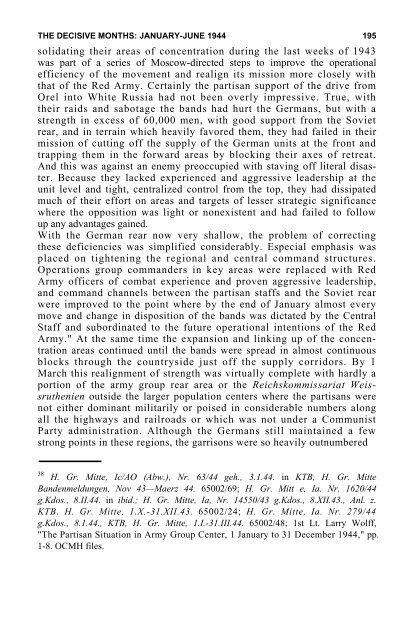the soviet partisan movement 1941-1944 by edgar m. howell
the soviet partisan movement 1941-1944 by edgar m. howell
the soviet partisan movement 1941-1944 by edgar m. howell
Create successful ePaper yourself
Turn your PDF publications into a flip-book with our unique Google optimized e-Paper software.
THE DECISIVE MONTHS: JANUARY-JUNE <strong>1944</strong> 195<br />
solidating <strong>the</strong>ir areas of concentration during <strong>the</strong> last weeks of 1943<br />
was part of a series of Moscow-directed steps to improve <strong>the</strong> operational<br />
efficiency of <strong>the</strong> <strong>movement</strong> and realign its mission more closely with<br />
that of <strong>the</strong> Red Army. Certainly <strong>the</strong> <strong>partisan</strong> support of <strong>the</strong> drive from<br />
Orel into White Russia had not been overly impressive. True, with<br />
<strong>the</strong>ir raids and sabotage <strong>the</strong> bands had hurt <strong>the</strong> Germans, but with a<br />
strength in excess of 60,000 men, with good support from <strong>the</strong> Soviet<br />
rear, and in terrain which heavily favored <strong>the</strong>m, <strong>the</strong>y had failed in <strong>the</strong>ir<br />
mission of cutting off <strong>the</strong> supply of <strong>the</strong> German units at <strong>the</strong> front and<br />
trapping <strong>the</strong>m in <strong>the</strong> forward areas <strong>by</strong> blocking <strong>the</strong>ir axes of retreat.<br />
And this was against an enemy preoccupied with staving off literal disaster.<br />
Because <strong>the</strong>y lacked experienced and aggressive leadership at <strong>the</strong><br />
unit level and tight, centralized control from <strong>the</strong> top, <strong>the</strong>y had dissipated<br />
much of <strong>the</strong>ir effort on areas and targets of lesser strategic significance<br />
where <strong>the</strong> opposition was light or nonexistent and had failed to follow<br />
up any advantages gained.<br />
With <strong>the</strong> German rear now very shallow, <strong>the</strong> problem of correcting<br />
<strong>the</strong>se deficiencies was simplified considerably. Especial emphasis was<br />
placed on tightening <strong>the</strong> regional and central command structures.<br />
Operations group commanders in key areas were replaced with Red<br />
Army officers of combat experience and proven aggressive leadership,<br />
and command channels between <strong>the</strong> <strong>partisan</strong> staffs and <strong>the</strong> Soviet rear<br />
were improved to <strong>the</strong> point where <strong>by</strong> <strong>the</strong> end of January almost every<br />
move and change in disposition of <strong>the</strong> bands was dictated <strong>by</strong> <strong>the</strong> Central<br />
Staff and subordinated to <strong>the</strong> future operational intentions of <strong>the</strong> Red<br />
Army." At <strong>the</strong> same time <strong>the</strong> expansion and linking up of <strong>the</strong> concentration<br />
areas continued until <strong>the</strong> bands were spread in almost continuous<br />
blocks through <strong>the</strong> countryside just off <strong>the</strong> supply corridors. By 1<br />
March this realignment of strength was virtually complete with hardly a<br />
portion of <strong>the</strong> army group rear area or <strong>the</strong> Reichskommissariat Weissru<strong>the</strong>nien<br />
outside <strong>the</strong> larger population centers where <strong>the</strong> <strong>partisan</strong>s were<br />
not ei<strong>the</strong>r dominant militarily or poised in considerable numbers along<br />
all <strong>the</strong> highways and railroads or which was not under a Communist<br />
Party administration. Although <strong>the</strong> Germans still maintained a few<br />
strong points in <strong>the</strong>se regions, <strong>the</strong> garrisons were so heavily outnumbered<br />
38<br />
H. Gr. Mitte, Ic/AO (Abw.), Nr. 63/44 geh., 3.1.44. in KTB, H. Gr. Mitte<br />
Bandenmeldungen, Nov 43—Maerz 44. 65002/69; H. Gr. Mitt e, Ia. Nr. 1620/44<br />
g.Kdos., 8.II.44. in ibid.; H. Gr. Mitte, Ia, Nr. 14550/43 g.Kdos., 8.XII.43., Anl. z.<br />
KTB. H. Gr. Mitte, 1.X.-31.XII.43. 65002/24; H. Gr. Mitte, Ia. Nr. 279/44<br />
g.Kdos., 8.1.44., KTB, H. Gr. Mitte, 1.I.-31.III.44. 65002/48; 1st Lt. Larry Wolff,<br />
"The Partisan Situation in Army Group Center, 1 January to 31 December <strong>1944</strong>," pp.<br />
1-8. OCMH files.
















